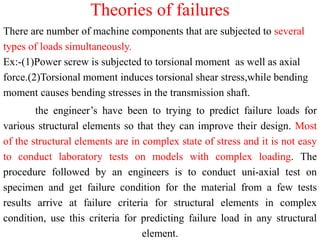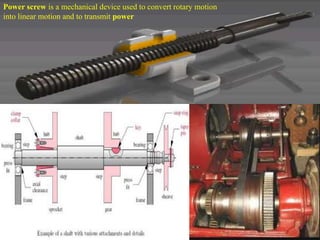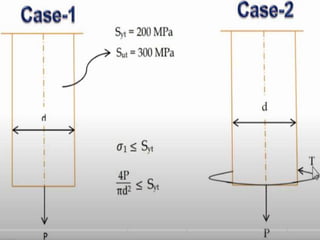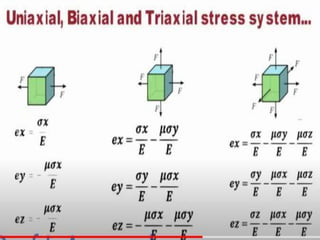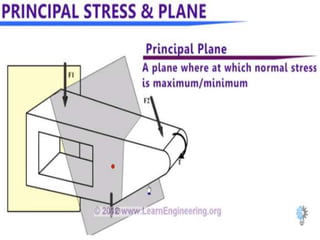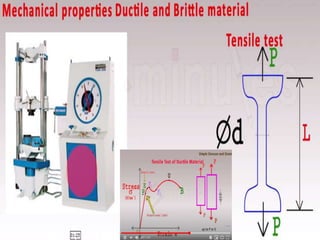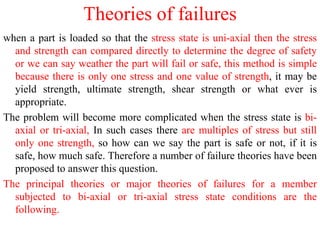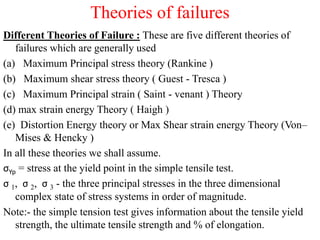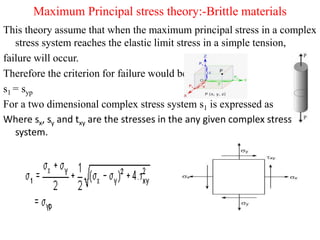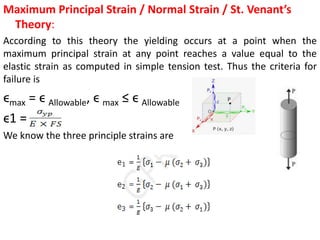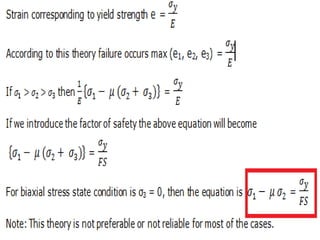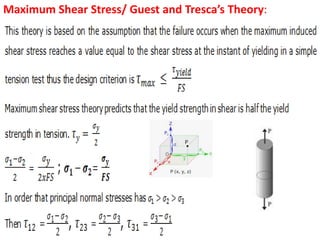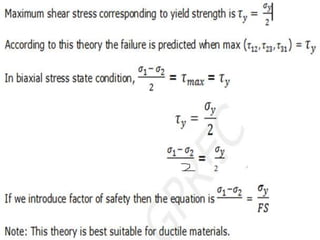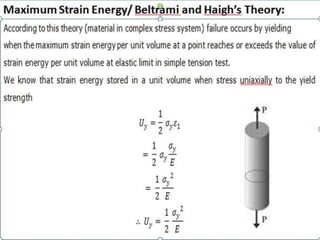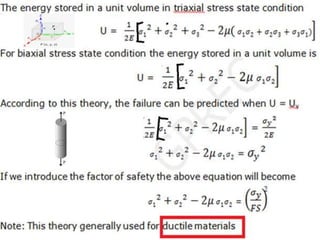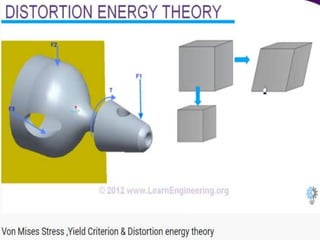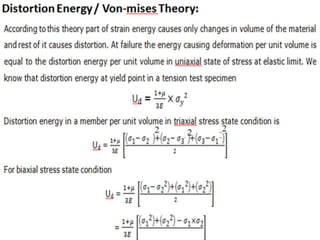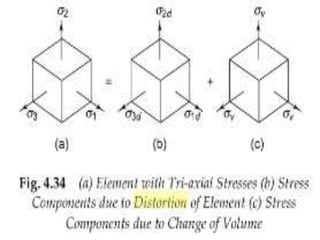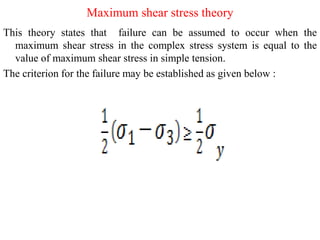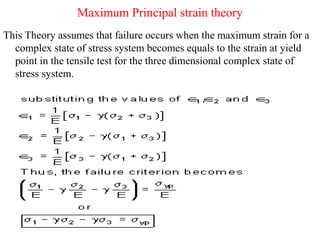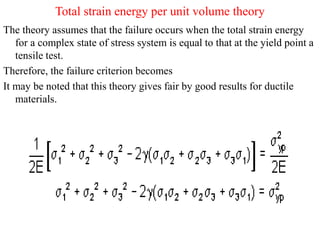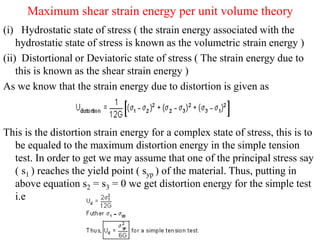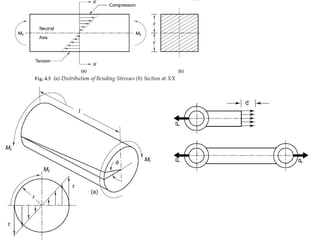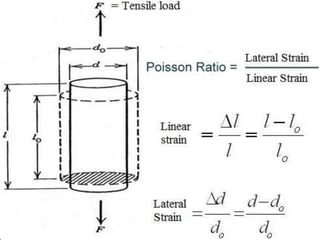UNIT-I-Theories of failures-19072016.pptx
- 1. Theories of failures There are number of machine components that are subjected to several types of loads simultaneously. Ex:-(1)Power screw is subjected to torsional moment as well as axial force.(2)Torsional moment induces torsional shear stress,while bending moment causes bending stresses in the transmission shaft. the engineer’s have been to trying to predict failure loads for various structural elements so that they can improve their design. Most of the structural elements are in complex state of stress and it is not easy to conduct laboratory tests on models with complex loading. The procedure followed by an engineers is to conduct uni-axial test on specimen and get failure condition for the material from a few tests results arrive at failure criteria for structural elements in complex condition, use this criteria for predicting failure load in any structural element.
- 2. Power screw is a mechanical device used to convert rotary motion into linear motion and to transmit power
- 7. Theories of failures when a part is loaded so that the stress state is uni-axial then the stress and strength can compared directly to determine the degree of safety or we can say weather the part will fail or safe, this method is simple because there is only one stress and one value of strength, it may be yield strength, ultimate strength, shear strength or what ever is appropriate. The problem will become more complicated when the stress state is bi- axial or tri-axial, In such cases there are multiples of stress but still only one strength, so how can we say the part is safe or not, if it is safe, how much safe. Therefore a number of failure theories have been proposed to answer this question. The principal theories or major theories of failures for a member subjected to bi-axial or tri-axial stress state conditions are the following.
- 8. Theories of failures Different Theories of Failure : These are five different theories of failures which are generally used (a) Maximum Principal stress theory (Rankine ) (b) Maximum shear stress theory ( Guest - Tresca ) (c) Maximum Principal strain ( Saint - venant ) Theory (d) max strain energy Theory ( Haigh ) (e) Distortion Energy theory or Max Shear strain energy Theory (Von– Mises & Hencky ) In all these theories we shall assume. σYp = stress at the yield point in the simple tensile test. σ 1, σ 2, σ 3 - the three principal stresses in the three dimensional complex state of stress systems in order of magnitude. Note:- the simple tension test gives information about the tensile yield strength, the ultimate tensile strength and % of elongation.
- 9. Maximum Principal Stress / Normal Stress / Rankine’s Theory According to this theory, the yielding at a point occurs only when the maximum principle stress in any plane passing through that point reaches a value equal to the elastic limit as computed in simple tension test. Thus criteria for failure is σ Max = σ Yield Point σ Max ≤ σ Allowable - Safe Condition Suppose we arrange the three principle stresses for any stress state in the ordered form σ1 > σ2 > σ3 then this theory predicts the failure occurs. Whenever σ 1 = σ yt or σ 1 = σ ut which ever is applicable. This theory considers only the maximum of principal stresses and disregards the influence of the other principal stresses. the dimensions of the component are determined by using a factor of safety. For Tensile Stress σ 1 = σ Yield Ten.Point /F.S or σ Ultimate Ten. Strength / F.S For Compressive Stress σ 1 = σ Yield Comp. Point / F.S or σ Ultimate Comp. Strength / F.S
- 10. Maximum Principal stress theory:-Brittle materials This theory assume that when the maximum principal stress in a complex stress system reaches the elastic limit stress in a simple tension, failure will occur. Therefore the criterion for failure would be s1 = syp For a two dimensional complex stress system s1 is expressed as Where sx, sy and txy are the stresses in the any given complex stress system.
- 11. Maximum Principal Strain / Normal Strain / St. Venant’s Theory: According to this theory the yielding occurs at a point when the maximum principal strain at any point reaches a value equal to the elastic strain as computed in simple tension test. Thus the criteria for failure is ϵmax = ϵ Allowable, ϵ max ≤ ϵ Allowable ϵ1 = We know the three principle strains are
- 13. Maximum Shear Stress/ Guest and Tresca’s Theory:
- 21. Maximum shear stress theory This theory states that failure can be assumed to occur when the maximum shear stress in the complex stress system is equal to the value of maximum shear stress in simple tension. The criterion for the failure may be established as given below :
- 22. Maximum Principal strain theory This Theory assumes that failure occurs when the maximum strain for a complex state of stress system becomes equals to the strain at yield point in the tensile test for the three dimensional complex state of stress system.
- 23. Total strain energy per unit volume theory The theory assumes that the failure occurs when the total strain energy for a complex state of stress system is equal to that at the yield point a tensile test. Therefore, the failure criterion becomes It may be noted that this theory gives fair by good results for ductile materials.
- 24. Maximum shear strain energy per unit volume theory This theory states that the failure occurs when the maximum shear strain energy component for the complex state of stress system is equal to that at the yield point in the tensile test. Hence the criterion for the failure becomes As we know that a general state of stress can be broken into two components i.e,
- 25. Maximum shear strain energy per unit volume theory (i) Hydrostatic state of stress ( the strain energy associated with the hydrostatic state of stress is known as the volumetric strain energy ) (ii) Distortional or Deviatoric state of stress ( The strain energy due to this is known as the shear strain energy ) As we know that the strain energy due to distortion is given as This is the distortion strain energy for a complex state of stress, this is to be equaled to the maximum distortion energy in the simple tension test. In order to get we may assume that one of the principal stress say ( s1 ) reaches the yield point ( syp ) of the material. Thus, putting in above equation s2 = s3 = 0 we get distortion energy for the simple test i.e
